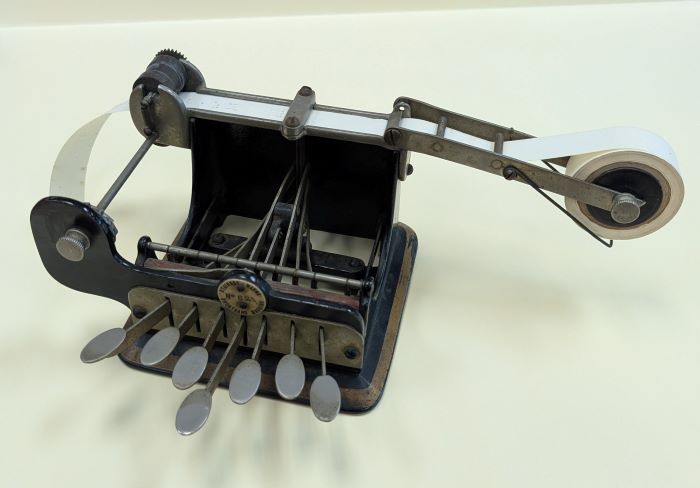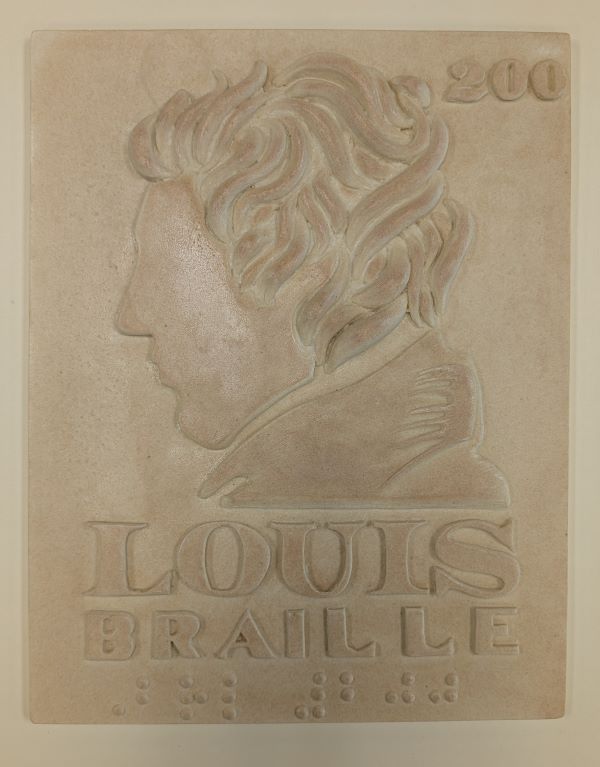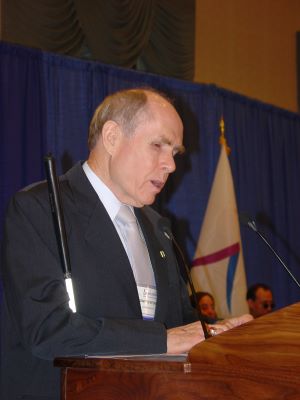Braille writing, created by the blind Frenchman Louis Braille, emerged as the dominant system of tactile writing after the War of the Dots. Early efforts at standardization and technological innovations helped Braille spread. However, many blind students still struggle to get access to Braille instruction.
Braille Shorthand Machine (circa 1920s)
A small black machine has seven keys on levers of varying length sticking out from the front. The machine is open in the middle and the levers converge in the back. In the back, a reel of narrow paper is fastened at one end of an arm, which is open to the right, and a strip of paper coming off the reel runs across the back with Braille embossed on it. The front of the machine is labeled “Stainsby-Wayne Shorthand Machine No. 62A.”

The first Braille typewriter was invented in 1892 by Frank H. Hall and, while a successful innovation to create written materials, it was still rather large. This Braille shorthand machine, produced by Stainsby-Wayne around the 1920s, provided a compact alternative. The arm at the top folds outward and holds a roll of paper that allows for only a single line of Braille, which can be torn off and taken with you. This shorthand machine would have had its own carrying case, although this example does not.
Louis Braille Relief (2009)
A rectangular plaque shows Louis Braille in profile, with thick locks of wavy hair and a high collar. At the bottom raised print text reads “LOUIS BRAILLE” with Braille embossing underneath. In the top right corner, raised print text says “200.”

Around 1825, a blind sixteen-year-old in Paris, France, named Louis Braille, invented his own system of writing, building on writing systems already in place. While there were multiple writing systems concurrently in use by blind people, eventually, Braille would become the standard alphabet. As we currently celebrate the 200th anniversary of the writing system Braille, this tactile plaque, featuring a portrait of Louis Braille in profile, was created by artist Anne Cunningham and designer Judith Krimski to honor the 200th anniversary of Louis Braille’s birth.
Visit the tenBroek Library website to read the first edition of Louis Braille’s code, Method for Writing Words, Music, and Plainsong in Dots in English or the original French.
Oral Histories of Learning Braille (2011-2012)
In order to document the personal stories of members in their own words, the National Federation of the Blind conducts oral history interviews. The interview with the late Federationist and bioethicist Adrienne Asch was recorded on April 26, 2012 by Ed Morman. The interview with longtime Federationist Tom Bickford was recorded on August 31, 2011 by Ed Morman. In these clips, they discuss their experiences learning Braille.
Adrienne Asch
Listen to Adrienne Asch's oral history below or read the Adrienne Asch's oral history transcript (2012).
Tom Bickford
Listen to Tom Bickford's oral history below or read the Tom Bickford's oral history transcript (2011) .

tenBroek Trivia
How many possible combinations of dots are there within the Braille cell (including the space, which is zero dots)?
Archive Navigation
Next Exhibit: Battle for Braille & Our Right to Read